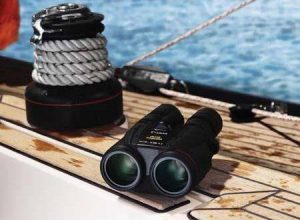 There comes a time when you’re ready to exchange your bargain entry binoculars for an investment-grade instrument.
There comes a time when you’re ready to exchange your bargain entry binoculars for an investment-grade instrument.
Canon doesn’t always show up on a high-end list: their famous Image Stabilization (IS) technology is a mass-market hit, so they don’t need to compete with the highest performers, and usually don’t.
Canon’s premium binoculars, the 10×42 L IS WP, are a bit different.
The company has put their best work into this model, and it’s gotten attention from all quarters. Let’s check out these binoculars and see if they belong on your list after all.
Canon 10×42 L IS WP Review
[wpsm_box type=”dashed_border” float=”none” text_align=”left” width=”100%” ]
[wpsm_column size=”one-half”]
[/wpsm_column]
[wpsm_column size=”one-half” position=”last”]
[wpsm_list type=”check” hover=”1″ gap=”medium”]
- Electronic Image Stabilization
- Ultra-Low Dispersion Lead-Free Glass
- Porro Prism Optical Path
- Fully Super Spectra Coatings
- Large Center Focusing Knob
- Twist-Up Eyecups
[wpsm_button color=”blue” size=”medium” link=”https://www.amazon.com/dp/B0007W4IW2/?tag=opticzoo-20″ icon=”none” class=”” border_radius=”0 px” target=”_blank” rel=”nofollow”]Check Price on Amazon![/wpsm_button]
[rehub_affbtn btn_text=”Check Price on B&H Photovideo!” btn_url=”https://bhpho.to/30nNFK1″ target=”_blank” ]
[/wpsm_column]
[/wpsm_box]
Canon decided to go all out with these bins, using their highest-quality “L” glass for the lens. These are the only binoculars the company has yet awarded with this vaunted glass.
Canon 10×42 L IS WP is housed in a sleek waterproof case which can be submerged in water without incident.
The style is ergonomic with comfortable eye relief … but the heart of these bins is the ocular assembly.
[wpsm_box type=”info” float=”none” text_align=”left”]
The L-glass and other high-grade elements work to make up for an inescapable loss of quality to the IS function. They succeed: these bins deliver remarkably crisp, clear, bright images with high color fidelity.
[/wpsm_box]
They have an ample field of view (FOV) and good low-light performance too, providing premium optics for wildlife- and sky-watching.
[wpsm_column size=”one-half”][wpsm_pros title=”PROS:”]
- Low dispersion L-glass for low chromatic aberration
- Image Stabilization
- Crisp, even image without fringing
- Wide FOV
- Waterproof design
- Excellent close-focus range
- Good low-light performance
[/wpsm_pros][/wpsm_column][wpsm_column size=”one-half” position=”last”][wpsm_cons title=”CONS:”]
- Expensive
- Requires AA batteries
- Inadequate lens covers
[/wpsm_cons][/wpsm_column]
Who are these Binoculars for?
The Canon 10×42 L IS WP binoculars are good all-rounders that can widely serve:
- Hunters – These are excellent field glasses with exceptional clarity and color rendition, and they don’t mind bad weather or even laying in a puddle. The low 10x magnification and FOV lets you sweep the landscape, and the IS brings out fine detail without shaking. Superior low-light capacity means you can get out early and stay late.
- Birders – Watching wildlife with a stabilized image brings viewing to a new level. Being able to discern tufts and whiskers is why you’re out there anyway, and these bins make it easy. Good low-light viewing and weatherproof construction just sweeten the package.
- Stargazers – Superior optical quality, IS, and a wide FOV make celestial viewing convenient and fun, as a stabilized image brings up more detail than a typical handheld view. You can step outside and just look up without setting up a tripod.
Who are these Bins not for?
These are expensive binoculars made to serve an average purpose — easy, clear viewing — so they won’t appeal to a bargain shopper.
[wpsm_box type=”warning” float=”none” text_align=”left”]
Also, though the optics are impressive, the IS will always cut the color and brightness a bit, which leaves out those demanding an extreme optical edge.
[/wpsm_box]
Highly-skilled surgeons who can hold objects perfectly still for minutes at a time may also not need the IS.
If you’re a serious, tripod-mounting astronomer, the convenience won’t matter and the magnification probably isn’t sufficient anyway. Purists will stand appalled it needs a battery.
Canon’s 10x42L bins are for those interested in a minimalist, handheld approach to their viewing. A little secret: even the purists would have fun with these bins, if you could get them to admit it.
Features
Crisp, Bright 10x Magnification
The 10x magnification makes these bins versatile as sighting glasses in the field.

The ample 42mm objectives soak in the light, which is further optimized with a generous 4.2mm exit pupil — larger than on any other Canon IS Binocular.
Top Optical Performance
The special L-glass Canon is made for ultra-low dispersion (UD) that reduces fringing and chromatic aberration.
The Porro Prism design has advanced field-flattening features that produce a consistent image throughout the view, not just at the center. The resulting high, precision contrast highlights detail in bright, accurate color.
[wpsm_box type=”info” float=”none” text_align=”left”]
A full set of anti-reflection films are applied, including Anti-reflective Sub-wavelength and Air Sphere coatings to reduce flare and ghosting.
[/wpsm_box]
Light transmission is optimized over the whole optical channel, which increases low-light ability so you can resolve pin-point detail against a night sky or a pre-dawn landscape.
Amazing Image Stabilization (IS)
This is the game changer that lets you get gorgeously detailed, tripod-steady views while holding the binoculars in your shaky hands.
With a stable image, it’s possible to see much more detail when stargazing or watching a distant preening bird.
You easily activate the IS with a single button located your right forefinger on the barrel: either hold it down while it operates, or activate a 5-minute session to avoid distraction.
Canon Binoculars IS Technology:
Wide Field of View (FOV)
These bins have an excellent FOV, with a real view field of 65°. This makes them great targeting glasses, as well as giving stargazers room to fit and frame celestial objects.
[wpsm_box type=”info” float=”none” text_align=”left”]
The image’s clarity and color have the same quality across the viewing area.
[/wpsm_box]
Most lesser bins produce their best image in the center, which degrades the further away you look — but these Canon binoculars are clear and crisp almost to the very edge of the image.
Superior Low-light Performance
These binoculars have exceptional low-light performance, beyond what the specs would have you expect. 42mm objectives are fairly standard, and the substantial FOV is within normal range.
The IS system is what makes these such nice twilight bins, because you can see more detail in the high contrast it affords. It outperforms many bins with 56-inch objectives in low light.
Effect of IS in Canon Image Stabilizer Binoculars:
All-Weather Construction
One of the main criticisms of IS binoculars is their lack of weatherproofing, but Canon has made these prized bins with full water-proof construction.
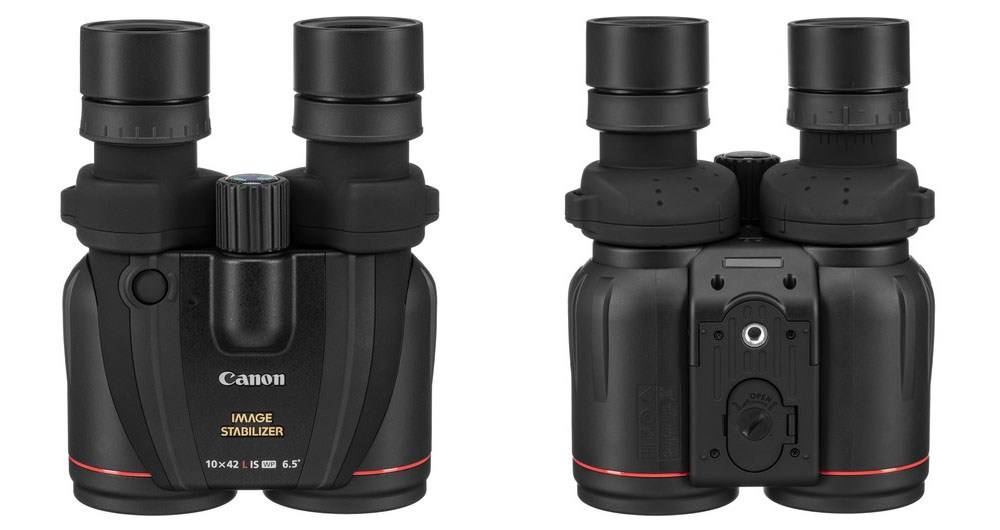
The bins use eco-friendly lead-free glass with O-ring seals for rugged durability, and are given a metallic anti-fog coating. You can pretty much take these swimming, though that’s not a recommendation.
However, Canon does recommend dunking them in a pail of water to clean them off … it’s a pretty serious feature.
Comfort & Handling
These bins have a comfortable, easy-to-grip housing with a large center wheel focus. There is a substantial 16mm eye relief, so they can be used with or without eyeglasses. The twist-up eyecups are hard and bulky, but effective.
[wpsm_box type=”warning” float=”none” text_align=”left”]
However … there are a couple of quibbles with the addendums. The rain covers for the eyepieces are loose and fall off in the rain, plus they tear easily. The carrying case is a bit too snug. The Diopter setting slips too easily.
[/wpsm_box]
Also, these bins are heavy at almost 2 ½ lbs. You pretty much need the IS to see a still image, even though these are only 10x magnification. There is a standard tripod mounting.
Finally, you will need to keep batteries on hand for replacement, as the IS function depletes them rather quickly. You can use common AA batteries, but you’ll only get two or three hours out of them. Lithium batteries last longer before they need to be replaced.
Alternatives
[wpsm_box type=”dashed_border” float=”none” text_align=”left” width=”100%” ]
1. Canon 10×30 IS II Review
[wpsm_column size=”one-half”]
[/wpsm_column]
[wpsm_column size=”one-half” position=”last”]
[wpsm_list type=”check” hover=”1″ gap=”medium”]
- Vari-Angle Prism Image Stabilization
- Eco-Friendly Lead-Free Glass
- Super Spectra Multicoated Optics
- Doublet Field-Flattener Lenses
- Center Focus Wheel
[wpsm_button color=”blue” size=”medium” link=”https://www.amazon.com/dp/B00XOGP13S/?tag=opticzoo-20″ icon=”none” class=”” border_radius=”0 px” target=”_blank” rel=”nofollow”]Check Price on Amazon![/wpsm_button]
[rehub_affbtn btn_text=”Check Price on B&H Photovideo!” btn_url=”https://bhpho.to/30uq0HM” target=”_blank” ]
[/wpsm_column]
[/wpsm_box]
If you like the Canon IS but not the expense, you might check out their Canon 10×30 IS II model.
These older bins are Canon’s bestselling model, and they have a lot of the same great optical quality at almost half the weight — and less than half the cost.
You won’t get the super-high optics of Canon’s fabled L-glass, but you get almost the same optical coatings and Porro prism design, and the IS is basically identical, too.
Forget the waterproofing and superior low-light performance … but you’ll still get a stunning, crisp image when skywatching or birding (in nice weather).
[wpsm_column size=”one-half”][wpsm_pros title=”PROS:”]
- Almost the optical quality of the 10x42L
- Similar IS performance
- Lighter weight: 21.2 oz. vs 39.2 oz
- Lower price
[/wpsm_pros][/wpsm_column][wpsm_column size=”one-half” position=”last”][wpsm_cons title=”CONS:”]
- Not Waterproof or Water-resistant
- Smaller FOV
- Shorter Eye Relief of 14.5mm (vs 16mm)
[/wpsm_cons][/wpsm_column]
Take a look for yourself!
[wpsm_box type=”dashed_border” float=”none” text_align=”left” width=”100%” ]
2. Canon 10×32 IS Review
[wpsm_column size=”one-half”]
[/wpsm_column]
[wpsm_column size=”one-half” position=”last”]
[wpsm_list type=”check” hover=”1″ gap=”medium”]
- Lens-Shift Image Stabilization
- Field-Flattener Lens System
- Super Spectra Multi-Coated Optics
- Normal and Powered IS Modes
- Simple 2-Button User Interface
- Large Center Focusing Wheel
[wpsm_button color=”blue” size=”medium” link=”https://www.amazon.com/dp/B0744NH94W/?tag=opticzoo-20″ icon=”none” class=”” border_radius=”0 px” target=”_blank” rel=”nofollow”]Check Price on Amazon![/wpsm_button]
[rehub_affbtn btn_text=”Check Price on B&H Photovideo!” btn_url=”https://bhpho.to/30t09A6″ target=”_blank” ]
[/wpsm_column]
[/wpsm_box]
The newest family of binoculars made by Canon use “Shift” technology with a moving lens for IS control.
If you’re looking for a 10x with IS and good optics, these new bins cost less, weigh less … and do a little less, too.
You probably won’t notice much optical difference with Canon 10×32 IS, even with inferior lens quality.
Canon’s optics are always a cut above. The exterior elements fall down a bit, since these don’t have weatherproofing of any kind. You do get a better close-focus range of just over 6 feet, and a more lightweight frame: but the main gain is in the price.
[wpsm_column size=”one-half”][wpsm_pros title=”PROS:”]
- Good optical quality but not equal to the 10x42L
- Similar IS performance
- Lighter weight: 27.5 oz. vs 39.2 oz
- Better close-focus distance: 6.6 vs 8.2 feet
- Lower price
[/wpsm_pros][/wpsm_column][wpsm_column size=”one-half” position=”last”][wpsm_cons title=”CONS:”]
- Not waterproof or water-resistant
- Shorter eye relief of 14.5mm (vs 16mm)
[/wpsm_cons][/wpsm_column]
Check them out for online!
[wpsm_box type=”dashed_border” float=”none” text_align=”left” width=”100%” ]
3. Fuji Techno-Stabi TS1440 14×40 Review
[wpsm_column size=”one-half”]
[/wpsm_column]
[wpsm_column size=”one-half” position=”last”]
[wpsm_list type=”check” hover=”1″ gap=”medium”]
- ±5° Stabilization
- Phase-Coated BAK4 Roof Prisms
- Full Fujinon EBC Multi-Coatings
- Optional Eyepiece Filters
- Fold-Down Eyecups
- Waterproof & Fogproof
[wpsm_button color=”blue” size=”medium” link=”https://www.amazon.com/dp/B0000C16R8/?tag=opticzoo-20″ icon=”none” class=”” border_radius=”0 px” target=”_blank” rel=”nofollow”]Check Price on Amazon![/wpsm_button]
[rehub_affbtn btn_text=”Check Price on B&H Photovideo!” btn_url=”https://bhpho.to/30nMpGN” target=”_blank” ]
[/wpsm_column]
[/wpsm_box]
If you want IS and are willing to look beyond the market leader, Fuji has a well-regarded line of stabilized binoculars.
They have good, clear optics and IS, along with an ergonomic feel and a fogproof, waterproof design.
These are a bit less expensive, but the Fuji’s don’t have quite the FOV or the evenness of the image that would make them Canon’s equals for stargazing.
The 2-switch power system is more complicated than Canon’s single-push activation.
Fuji Techno-Stabi TS1440 14×40 uses a greater correction angle with their IS system, which makes them very popular for boating on rough seas. You’ll also get a much better carrying case. Decisions, decisions.
[wpsm_column size=”one-half”][wpsm_pros title=”PROS:”]
- Solid IS performance—though less smooth than Canon’s
- Waterproof and Fogproof
- Lower price
[/wpsm_pros][/wpsm_column][wpsm_column size=”one-half” position=”last”][wpsm_cons title=”CONS:”]
- Inferior low-light performance
- Smaller FOV
[/wpsm_cons][/wpsm_column]
Check them out for yourself!
Conclusion
If you’ve ever looked through a Canon with IS, you know why people get excited about these binos. There are many contenders that claim IS now, and the 10x42L is Canon’s attempt to stay on top of the melee. They mostly succeed too.
[wpsm_box type=”info” float=”none” text_align=”left”]
The 10x give weatherproofing to the hunters, low-light performance and wide FOV to the birders, and crisp, accurate optics to astronomers.
[/wpsm_box]
These bins show that Canon knows what consumers want … and how deliberately they avoid giving it to them without ransom. But that’s another review.
The main downsides to these excellent bins are its 2+ lb weight, their expense, and the crummy lens covers (but we’ll let that one go).
If these objections aren’t important to you, these binos are probably no-brainers for convenience and quality.
Overall these are excellent, versatile bins that anyone can enjoy, no matter their level of experience. It’s Canon’s top model, and a high point in their offerings. They are expensive, but you do get what you’re paying for.
Click here to check them out!
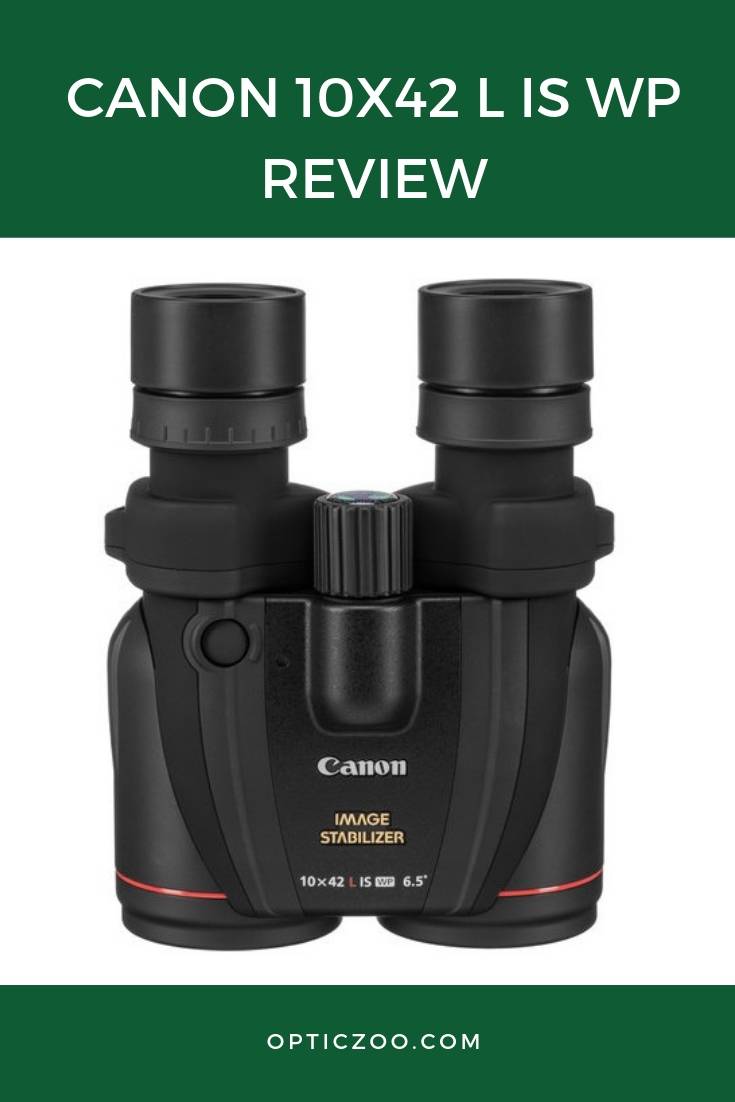

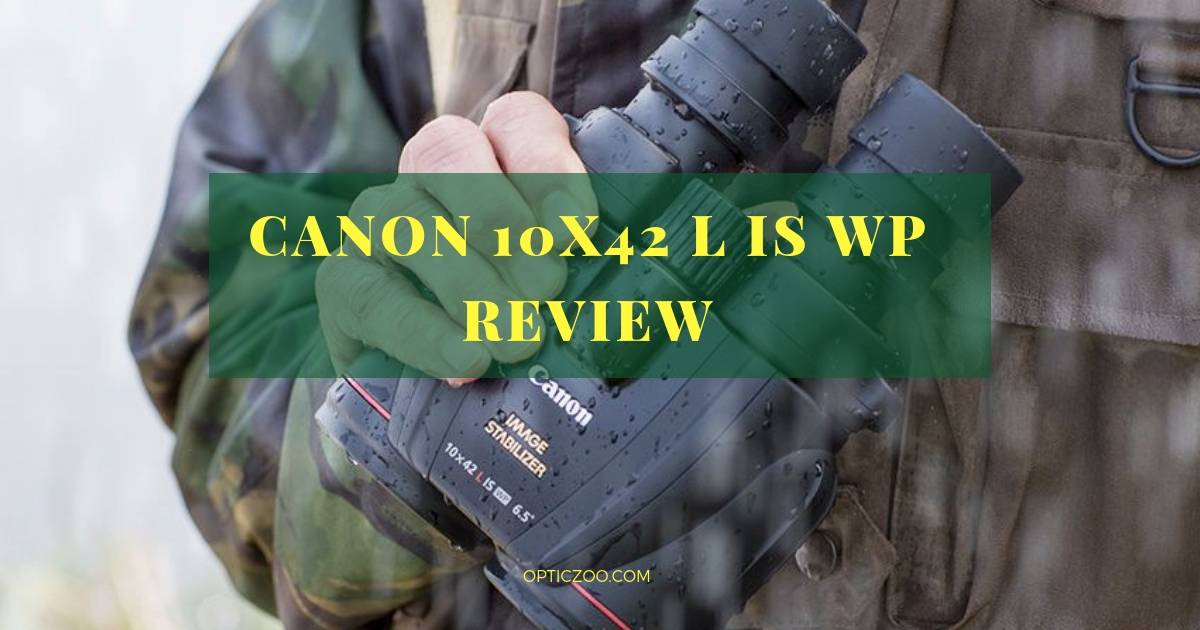

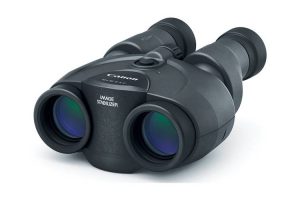
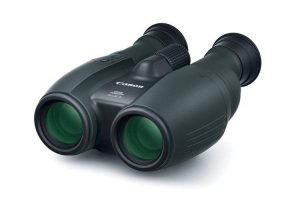
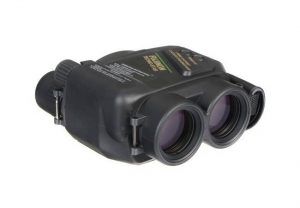
I’ve had the 10×42 L IS binos for a number of years and use them a lot, especially for birding while kayaking, and star gazing. I have about thirty pairs of other binoculars and these are almost the only ones I use. They have all the positive features that are recognized across the board. One criticism that is often seen is the poor fit of the objective covers. I cannot stress enough, that these are excellent covers that work as well as any that I have used, for instant mounting and dismounting. The thing is, you have to buy a set of camera filters to screw into the provided threads around the objectives. The filters also have to have threads on both sides of the glass. This is standard on most UV or skylight filters. The lens caps then snap in and out of the threads on the filters, beautifully. That’s what they are designed to do. My filters are US made Tiffen Haze-1, 52 mm. These also serve to protect the lens from getting scratched. They can be replaced where the objectives cannot. If the binoculars get wet, the filters have to be removed to dry out the objectives because the threads are not water tight. Canon tell you how to wash of your binos in a bucket, but they fail to tell you that you need to purchase filters to make the covers usable. Perhaps Canon assumed, being a camera manufacturer, that everyone would do this naturally. No photographer goes out to take pictures without a protective filter on all his lenses. The rubber beauty ring on the binoculars cleverly serves to secure the filters but it also prevents the dust covers from snapping in. You just need to buy a set of sky-light filters! Then the covers stay put.